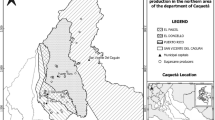Abstract
Village ecosystem function of the Khasis in Meghalaya was studied. The land has been desertified around Cherrapunji as the traditional slash and burn agriculture (jhum) has been replaced by plantation systems. Apart from mixed plantations with areca nut, orange, jackfruit, bay leaf, black pepper and betel leaf, broom grass, thatch grass and bamboo are also raised in the village. All the systems generally are economically viable and have a high energy efficiency with labour as the major input. Poultry and swine husbandry are two animal husbandry systems in the village. Both are largely detritus based. About 9% of the produce from mixed areca nut plantation, 50% from the bamboo and entire produce of thatch grass is utilized within the village and the rest is exported. In the absence of agriculture much of the food for consumption is imported from outside the village boundary. The possibility of further useful changes needs evaluation with scientific inputs.
Similar content being viewed by others
References
Akachuku A E 1985 Cost-benefit analysis of wood and food components of agri-silviculture in Nigerian forest zone;Agroforestry Syst. 3 307–316
Andreae B 1980The economics of tropical agriculture (England: Commonwealth Agriculture Bureaux)
Arnason T, Lambert J D H, Gale J, Cal J and Vernon H 1982 Decline of soil fertility due to intensification of land use by shifting agriculturists in Belize, Central America;Agro-Ecosystems 8 27–37
Boojh R and Ramakrishnan P S 1983 Sacred groves and their role in environmental conservation; inStrategies for environmental management Souvenir volume (Lucknow: Dept. Sci. and Environment) pp 6–8
Boonkird S A, Feranandes E C M and Nair P K R 1984 Forest villages: an agroforestry approach to rehabilitating forest land degraded by shifting cultivation in Thailand;Agroforestry Syst. 2 87–102
Brody S 1945Bioenergetics and growth (New York: Hafner Publishing Co.)
Clarke W C 1976 Maintenance of agriculture and human habitats within the tropical forest ecosystem;Hum. Ecol. 4 247–259
FAO/SIDA 1974Report on regional seminar on shifting cultivation and soil conservation in Africa (Rome: Food and Agriculture Organization)
Gangwar A K and Ramakrishnan P S 1987 Agriculture and animal husbandry among the Sulungs and Nishis of Arunachal Pradesh;Soc. Action 37 345–372
Gopalan C B, Ramasastri V and Balasubramanian S C 1985Nutritive value of Indian foods (Hyderabad: National Institute of Nutrition)
Gross D R, Eiten G, Flowers N M, Looi R M, Ritter M L and Werner D W 1979 Ecology and acculturation among native peoples of Brazil;Science 206 1043–1050
Harwood R R and Price E C 1976 Multiple cropping in tropical Asia; inMultiple cropping ASA Special Publication No. 27 (Madison: American Society of Agronomy) pp 11–44
Khiewtam R S 1986Ecosystem function of protected forests of Cherrapunji and adjoining areas, Ph.D. thesis, North-Eastern Hill University Shillong
Leach G 1976Energy and food production (Guildford: IPC Science and Technology Press)
Maikhuri R K 1987Studies on tribal village ecosystem function in north-eastern hill region of India, Ph.D. thesis, North-Eastern Hill University, Shillong
Mishra B K and Ramakrishnan P S 1981 The economic yield and energy efficiency of hill agroecosystems at higher elevations of Meghalaya in north eastern India;Acta Oecol./Oecol. Appl. 2 369–389
Mishra B K and Ramakrishnan P S 1982 Energy flow through a village ecosystem with slash and burn agriculture in north-eastern India;Agric. Syst. 9 57–72
Mitchell R 1979An analysis of Indian agro-ecosystems (New Delhi: Interprint)
Mitchell R 1984 The ecological basis for comparative primary production; inAgricultural ecosystems (eds) R Lowrance, B R Stinner and G J House (New York: John Wiley) pp 13–53
Nair P K R 1984Alternative and improved land use systems to replace resource-depleting shifting cultivation. Paper for expert consultation on strategies, approaches and systems for integrated watershed management (Rome: Food and Agriculture Organization, Forest Resources Division)
Odum E P 1975Ecology: The link between the natural and social sciences Second edition (New York: Holt, Reinhart and Winston)
Ram S C 1986Ecosystem structure and functions of seral communities of degraded environment at cherrapunji and adjoining areas, Ph.D. thesis, North-Eastern Hill University, Shillong
Ramakrishnan P S 1985a Conversion of rainforests in north-eastern India; inEnvironmental regeneration in the Himalaya: Concepts and strategies (ed.) J S Singh (Nainital; Central Himalayan Environment Association) pp 69–84
Ramakrishnan P S 1985b Tribal man in the humid tropics of the North-East;Man India 65 1–32
Ramakrishnan P S, Toky O P, Mishra B K and Saxena K G 1981 Slash and burn agriculture in north-east India; inFire Regimes and ecosystem properties (eds) H Mooney, T M Bonnicksen, N L Christensen, J E Lotan and W A Reiners (Washington: USDA For. Serv. Gen. Tech. Rep.) pp 570–586
Ranjhan S K 1977Animal nutrition and feeding practices in India (New Delhi: Vikas Publ. House Pvt. Ltd.)
Rao K S and Ramakrishnan P S 1988 Architectural plasticity of two bamboo species (Nehouzeua dulloa A. Camus andDendrocalamus hamiltonii Nees and Arn.) in successional environments in north-east India;Proc. Indian Acad. Sci. (Plant Sci.) 98 121–133
Rappaport R A 1971 The flow of energy in an agricultural society;Sci. Am. 225 117–132
Ruthenberg H 1971Farming systems in the tropics (Oxford: Clarendon Press)
Saxena K G and Ramakrishnan P S 1983 Growth and allocation strategies of some perennial weeds of slash and burn agriculture (jhum) in north-eastern India;Can. J. Bot. 61 1300–1306
Toky O P and Ramakrishnan P S 1983 Secondary succession following slash and burn agriculture in north-eastern India. I Biomass, litterfall and productivity;J. Ecol. 71 735–745
Watson G A 1983 Development of mixed tree and food crop system in the humid tropics: a response to population pressure and deforestation;Exp. Agric. 19 311–332
Author information
Authors and Affiliations
Rights and permissions
About this article
Cite this article
Gangwar, A.K., Ramakrishnan, P.S. Ecosystem function in a Khasi village of the desertified Cherrapunji area in northeast India. Proc. Indian Acad. Sci. 99, 199–210 (1989). https://doi.org/10.1007/BF03053594
Received:
Revised:
Issue Date:
DOI: https://doi.org/10.1007/BF03053594




